
Democratic Donkey
In the courtyard of the Old City Hall is a statue of a Donkey and a pair of elephant footprints.
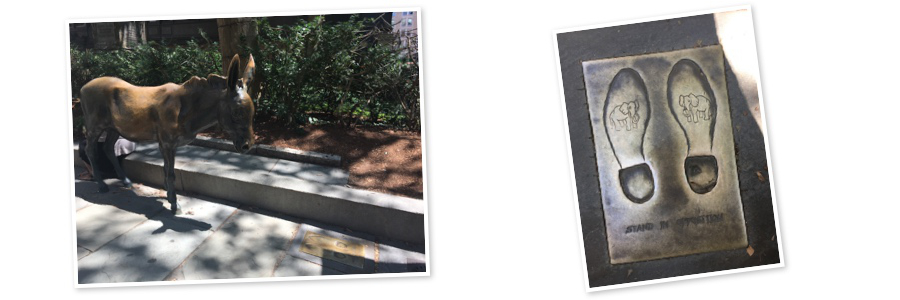
Interesting things that I learned about the Democratic Donkey
- Placed in 1998.
- Created by Antonio Frilli
- Statue was purchased by Roger Webb while vacationing in Florence, Italy.
- Roger Webb is the founder of the Architectural Heritage Foundation in Boston and help launch Preservation Massachusetts, a statewide nonprofit historic preservation organization.
- Roger wanted the statue so that children had a place to play as they walked the Freedom Trail.
- The City of Boston declined the initial request to install the statue along the Freedom Trail as they felt it wasn't appropriate to install an Italian Donkey.
- Rodger was able to convince the City when he explained that the Donkey was the symbol of the Democratic Party since the 1840s. The twenty mayors of Old City Hall used the mascot and the Bronze Donkey would be a symbol of that time.
- The Donkey is looking down at a pair of elephant footprints cast in bronze. (The Republican symbol is in the footprints.)
- There is a message before the footprint which reads, "Stand in Opposition."
- The bronze footprints were installed at the request of the Republican Party.
- The footprints were installed in 2001.
Democratic Donkey and the Republican Elephant
They were the inventions of Thomas Nast, an illustrator who became America's preeminent political cartoonist. Nast's donkey first appeared as a Democratic party symbol in Harper's Weekly on Jan. 15, 1870. The elephant turned up in Harper's four years later.
PermalinkWilliam H. Sumner
Every day about 20,000 commuters travel through the Sumner tunnel from East Boston to Downtown Boston. Here's some information about the person that the tunnel is named after.
Five General Information Facts about William H. Sumner
- William Hyslop Sumner was born in Roxbury, Massachusetts on July 4, 1780, the
- In 1789, when he was only 9 years old, William H. Sumner saw President Washington last visit to Boston.
- He attended Harvard Law School and served as a member of the Great and General Court.
- He was the Commander of the Massachusetts forces during the War of 1812
- He was the Adjutant General of Massachusetts from 1818 - 1835 The Adjutant General is a member of the Massachusetts Governor's Cabinet and advises the Governor on military and emergency management matters.
- He developed East Boston from marshland into a busy seaport.
- In 1833 he established a ferry service from East Boston to Boston. The service was called "The Sumner Ferry"
- Wrote several books including the Reminiscences of Lafayette's visit to Boston, History of East Boston, and Some Recollections of Washington's Visit to Boston as well as some others. All of his books are available at the Boston Public Library Central Delivery desk for in-library use only.
- Died in Jamaica Plain in 1861
Mentioned in Edward M. Kennedy: "Chappaquiddick" speech (Top 100 American Speeches):
The people of this state, the state which sent John Quincy Adams, and Daniel Webster, and Charles Sumner, and Henry Cabot Lodge, and John Kennedy to the United States Senate are entitled to representation in that body by men who inspire their utmost confidence. For this reason, I would understand full well why some might think it right for me to resign. For me, this will be a difficult decision to make.Permalink
Copley Outbound T Exit
If you're taking the Green Line from Park Street to Copley Square you end up exiting up the street at a different location than the inbound trains. The outbound trains end up under the intersection of Boylston Street and Dartmouth Street. The inbound train ends up near the Boston Public Library Main Entrance.
What???s tricky is that as you walk through the terminal, there???s no clear indicator on where you appear at street level. This is important because you don???t want to exit to street level and then find that you have to cross the street because you came out of the wrong door.
The exit are separated by Dartmouth Street, and the exits are on opposite sides of the street.
Check out this picture:

There are no signs to indicate where the exits will take you!
Helpful Tip!
You should go left if you want to go to the Boston Public Library, visit the Boston Marathon Finish Line, Apple Store or the Old South Church. Exit right if you want to go to Copley Square, Trinity Church and CVS.
Perhaps someday the MBTA will put up a sign to help people navigate out of the station properly.
Note: Some people may think this is a silly blog post. But it can be frustrating when you arrive at the station and have no clue on which exit to take.
PermalinkBoston Public Library Bronze Doors
When you enter the Boston Public Library from Copley square you may not have paid attention to the Bronze doors that you walk through.
These doors were created by Daniel Chester French in 1897, about 20 years before he did the Abraham Lincoln statue at the Lincoln Memorial.

Click on image for a larger version.
Five Things that I learned about the doors
- Each door weighs 1500 pounds.
- Daniel Chester French was chosen to create the doors by Charles Follen McKim, the Boston Public Library main architect since they worked on eight other projects together.
- The figures on the doors represent Music and Poetry, Knowledge and Wisdom, and Truth and Romance.
- The Center door, Knowlege and Wisdom, is the one that is always open.
- The door sayings are written in old Latin, Old Latin used V for capitals and U for lower case.
It took a while for each door panel to be completed:
- 1897 - Truth and Romance (Right)
- 1898 - Knowledge and Wisdom (Center)
- 1902 - Music and Poetry (Left)
Door Sayings
SVCG Sweet Compulsion Does in Music Lie To Lull the Daughters of Necessity and Keep Unsteady Nature to Her Law
True Poetry is Like the Loadstone Which Both Attracts the Needle and Supplies it With Magnetic Power
There is in Wisdom a spirit subtil, clear in utterance, loving what is good, pure, stedfast.
By Knowledge Shall, the Chambers Be Filled with all Precious and pleasant riches. (Proverbs 24:4)
Truth is The Strength and The Kingdom and The Power and the Majesty of all Ages A Romance to Rede and Drive the Night Away from me thought it Better Play than Either at Chesse or Tables
PermalinkBova's Bakery
Most people that visit the North End usually end up eating dessert at Mike's Pastry or Modern Pastry. Both places are extremely popular and quite often you'll find long lines that overflow onto Hanover Street.
Next time you're in the North End and want a dessert to treat to try - Bova's Bakery. It's usually a lot less crowded and pretty much has the same food selection.
Bova's Bakery is a Family-owned bake shop, opened in 1932, offering up delicious loaves of bread, cookies & sandwiches 24 hours a day.
Description from their website:
Visit us and celebrate a family history made around the oven. North Enders will tell you, there's nothing quite so comforting as walking home in the early morning with a warm loaf of bread carefully cradled in the crook of your arm. Once home, you sit down at the kitchen table, sneak the butter from the fridge, and open a jar of jam. With mounting anticipation, you prepare for a delicious breakfast.
Photos
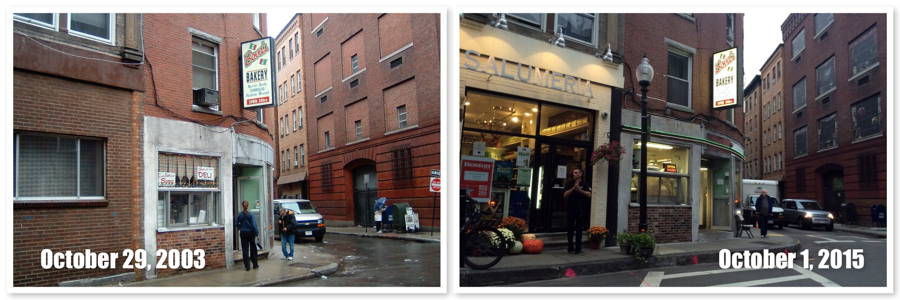
Click on image for a larger version.

Not always crowded like some of the popular bakeries on Hanover Street.
Misc Bova's Bakery Info
Anthony Martignetti, of the Prince Spaghetti Boy commercial from the 1970s, worked at Bova's Bakery at night
You can see Bova"s Bakery in the Fever Pitch Movie. The main character lived right upstairs.
Food Selection
I have found that they have a better selection of desserts than Mikes Pastry. I have enjoyed their homemade Italian cookies and fig bars.
I don't have a go-to item, I just browse around and see what looks good.
Bova`s Bakery has sandwiches and pizza too, which I keep thinking of having but the desert treats are a meal in themselves.
The Whoopie Pie is really good, kids will enjoy the character versions such as Cookie Monster.
Hours
Always Open - Open 24 hours!
According to Google, the most popular time is between 6 and 9, but the bakery does appear to get considerable amount of late night traffic.

Location
Bova's Bakery, located at the intersection of Prince Street and Salem Street. The Street address for Google/GPS is 134 Salem St, Boston, MA 02113
It's a quick 10-minute drive from Logan Airport via Taxi. Which is good to know if you have some layover time and want to grab some great Italian food.
PermalinkBoston Museum of Science Notables
The Boston Museum of Science has a lot of fun and interesting exhibits. Many of them are interactive which makes it fun to learn.
With all various exhibits to see, there are a few which you may miss. Here are a couple that I think are pretty interesting :
Dinosaur Coprolite

Have you ever touched Dinosaur Poop? Well you can at the Boston Museum of Science.
My six-year-old daughter always gets a kick out of the Dinosaur poop. We joke about it as we drive to the museum:

The "poop" is several million years old and is just a fossil remain. So touching it is just like touching any rock.
There is a sign next to fossilized remain to let you know what it is:
The photograph below is a magnified slice from the coprolite, fossilized dinosaur "poop". From the evidence, we can figure out the coprolite is from a plant-eating dinosaur that lived during the Jurassic period. You can observe the cell structure from some of the indigested plant material.
Every time we go she feels that she has to take a picture of me touching the poop.
You can find the Dinosaur poop along the back wall in the Dinosaur Area on the first floor,
Giant Sequoia Tree

There is a large tree cross-section in the main exhibit area. This was once part of a 2000+-year-old tree.
There is a sign in front of the cross-section of the tree:
The cross-section is from a Giant Sequoia that was cut down in 1950 in Sequoia National Park, CA after being badly damaged. It was 240 feet tall and 2044 years old. The gap on the upper right was caused by a fire hundreds of years ago. Sequoias are well-adapted to withstand fire: they are covered by a thick, fibrous bark that has very little flammable resin. The tree survived and kept growing as the two sides curved around to protect the exposed wood.
Imagine all the winter storms and droughts that the tree had to live through over the past couple of centuries.
There are 9 points on the Giant Sequoia Tree that the museum highlights. You can press a button to see the year on the tree ring:
- 95 BCE - Tree started to grow
- 1 CE - The start of the Gregorian Calendar
- 476 - End of the Roman Empire
- 1000 - Leif Ericsson arrived in North America
- 1495 - Leonardo da Vinci painted the Last Supper
- 1610 - Galileo discovered moons around Jupiter
- 1775 - Industrial Revolution begins in Britain
- 1833 - Giant Sequoia discovered by Europeans
- 1940 - Research into the technology to develop the Nuclear bomb.
The Giant Sequoia is one of Michael Bloomberg favorite exhibits at the museum. Last year he donated $50 million to the Boston Science Museum.
Locating the Giant Sequoia
It's not hard to miss the Giant Sequoia tree, its located in the main hall between the bathrooms and the back staircase.
Did you know: If you're interested in starting your own giant sequoia tree, you can purchase a starter kit in the museum gift shop. Just ask someone in the store if you need help finding it.
PermalinkSenator Charles Sumner Statue
In the Boston Public Gardens, along Boylston Street, are four bronze statues on granite pedestals that have stood as a group for more than eighty years.
The first statue to be placed on this path is simply labeled, 'Sumner.' This is a statue of Massachusetts Senator Charles Sumner.
Today's post is about Senator Charles Sumner.
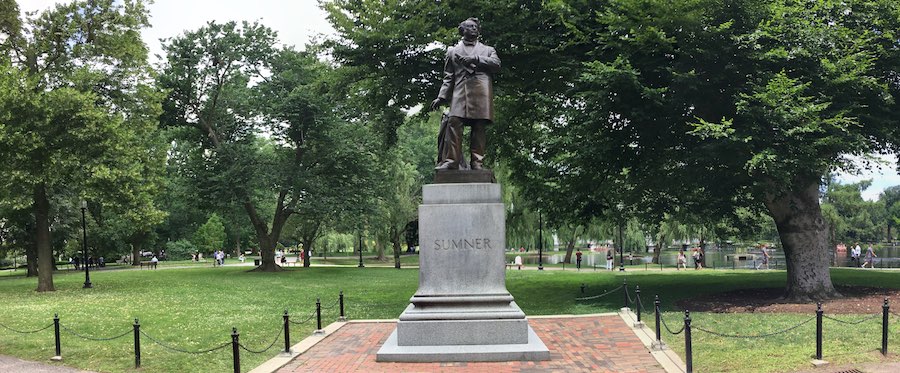
Five things that I learned about the Charles Sumner Statue
- Statue was unveiled on December 23, 1878 (4 years, 9 months, 13 days after Charles Sumner died)
- The face of the statue is faccing towards the Four Season Hotel on Boylston Street.
- There is a small inscription "Tomas Bell Sc. 1877" near the right foot. (This is a typical artist signature)
- There are No quotes or Inscriptions on the granite other than the last name on the Statue.
- Charles Sumner is holding a scroll - which I assume characterize his devotion to his work in the Senate.
- There are three lights around the statue, two in the front and one in the back. So the status will be visible at night.
Ten General Information Facts about Charles Sumner
- Born in Boston on January 6, 1811 and lived on Irving Street on Beacon Hill
- Attended Boston Latin School and graduated Harvard in 1830
- Republican Senator from Massachusetts from April 24, 1851 to March 11, 1874
- Had strong anti-slavery views.
- On May 22, 1856, He was attacked with a cane in the Senate by Preston Brooks after Charles Sumner suggested that Kansas should enter the Union as a free state.
- Introduced the the 13th Amendment to the Senate in 1864
- Fought hard for the Impeachment of Andrew Johnson, when the Senate Acquitted Johnson, Charles Sumner wanted to try again.
- Died in Washington DC on March 11, 1874 (Age 63)
- Buried at Mount Ardburn Cemetery
- Papers of Charles Sumner can be found in Microfilm in the Boston Public Library in Copley Square
Controversy over the Charles Sumner Statue
In 1876, the Boston Art Committee put out a formal notice that they were looking for a statue design for Charles Sumner to be placed in the Boston Public Gardens. They held a contest at the Old State House with several prominent designers showcasing their statue idea.
After much consideration, the committee picked the design done by Anne Whitney in a blind competition. However, when she went to collect her reward they rejected the design since the sculptor was a woman. The committee didn't like the idea of women designing a man's leg.
The committee then selected Thomas Ball designed instead. (Anne Whitney still kept the prize money.)
In 1902, the version of the statue Anne Whitney's created was placed in a small park across from Harvard University in Harvard Square in Cambridge, Massachusetts.
Anne Whitney got the last laugh as her version of Charles Sumner statue is seen far more than Thomas Ball version.
Fighting for Civil Rights
Charles Sumner fought hard for Civil Rights. One of the last bills he introduced to the Senate was a civil rights bill to guarantee to all citizens, regardless of color, "equal and impartial enjoyment of any accommodation, advantage, facility, or privilege." On his death bed he asked Frederick Douglas - "Don't let the bill fail!" and "You must take care of [my] civil-rights bill."
The Civil Right Act of 1865 passed on March 1, 1865, almost a year to the day that Charles Sumner died. The act was also known as the Butler-Sumner Act.
However, seven years later the Supreme Court threw out the Civil Rights Act of 1875 in four rulings: United States v. Stanley; United States v. Ryan; United States v. Nichols; United States v. Singleton; Robinson et ux. v. Memphis & Charleston R.R. Co.
It would be another 80 years before Congress could pass a civil rights act.
East Boston Sumner Tunnel
The tunnel between East Boston and Boston is called the Sumner Tunnel. However, it's named after William H. Sumner and not Charles Sumner.
William H. Sumner was responsible for building up East Boston, that's why the Tunnel is named after him. Charles Sumner had nothing to do with East Boston.
Both men did live around the same time, but they are not related.
Locating The Statue
The statue is located in the Boston Public Gardens along Boylston Street.
At the corner of Arlington and Boylston take the right most path in the Public Gardens. It will be the first statue on your left.
Tip: You can get some nice pictures of the Swan Boats from this location.
PermalinkRed Bear on David Ortiz Bridge
This summer, as you walk to Fenway Park from Kenmore Square, if you look down on the sidewalk you may see a strange red character:

This has nothing to do with the Boston Red Sox, it???s actually the Grateful Dead Dancing Bear. Apparently, a fan painted it on the sidewalk.
The Dancing Bear is as much a part of the Grateful Dead experience as the Steal Your Face logo or the Skull and Roses design. Artist Bob Thomas' Dancing Bear is on just about every Grateful Dead T-Shirt.
Fenway Park Summer Concert Series
Fenway Park has a very busy summer, aside from the usual baseball fun.
- June 17,18 Dead & Company
- July 8 - New Kids On The Block With Paula Abdul & Boyz II Men
- August 11 - James Taylor with with special guest Bonnie Raitt
- August 30 - Billy Joel
- September 1, 2 - Lady Gaga
Elm Trees at the Shaw Memorial
Have you ever walked around in the Boston Commons near the Park Street station and looked over at the State House building. Have you wondered why you can't see the State House building? In the summer you can only see the top of the gold dome.
What are those ugly trees there? Why don't they just cut them down and let everyone see the beautiful State House building?

Oldest Elms Trees on the Commons
Those ugly trees are confirmed to be the Oldest Elms trees in the Northeast.
In 1780 John Hancock sought permission to plant trees in the park across his residence on Beacon Hill. The city of Boston agreed with his request
Yes, that John Hancock. The first person to sign the Declaration of Independence and who later became the first governor of Massachusetts. Not to mention that he played a critical role in the revolutionary war. He planted those trees that you see at the Shaw Memorial.
Tree experts estimated that they were planted sometime between 1772 and 1812. I believe that the trees were planted someplace else and then transported to the Boston Gardens in 1780.
This year the set of trees will be at least 237 years old.

Great Elm of the Boston Commons vs The Elm at the Shaw Memorial
Last year I wrote about the famous Great Elms of the Boston Gardens. Nobody knows exactly when that tree was planted, and by whom. (Some say it was planted by Capt. Daniel Henchman in 1670)
When the Great Elm of the Boston Commons came down in 1875 it was estimated to be about 206 years old.
The Shaws Memorial Elms is currently at least 237 years old. (Based on being planted on 1780 ) This makes it the oldest Elm on the Boston Commons.
This means that the Oldest tree in the Boston Commons is the set of Elm Trees around the Shaw Memorial.
While researching about the trees in the Commons and Gardens, I did learn that there is another tree that is older in the Public Gardens. Public Gardens officials have not disclosed which tree it is so that no harm will come to that tree.
Elm Trees are in a Music Sheet from 1830
In a Illustrated music sheet cover from 1830, you can see the three Elm Trees right in front of the State House. This was done about 50 years after the trees were planted.
You can see the small trees growing up in front of the State House.
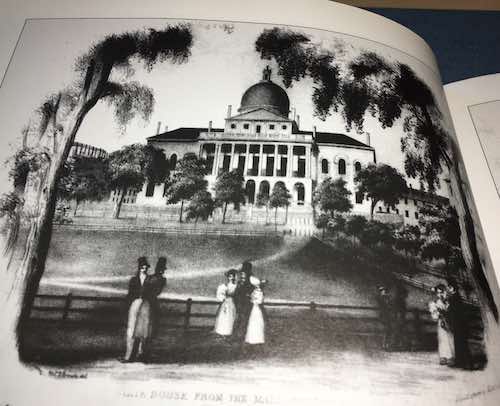
Special Care
Since the 1970s these trees have received the VIP treatment. The special tree experts check out the trees every couple of weeks and make sure that they are doing well.
Bricks were placed in one of the trees to keep the tree stable and to prevent any damage to the inside of the tree.
There was concern about the trees when the Shaw Memorial was built in xxx. The memorial has actually helped prolong the tree's life by protecting the tree from tree diseases that have killed many Elm trees in the Public Gardens.
Check Out the Trees
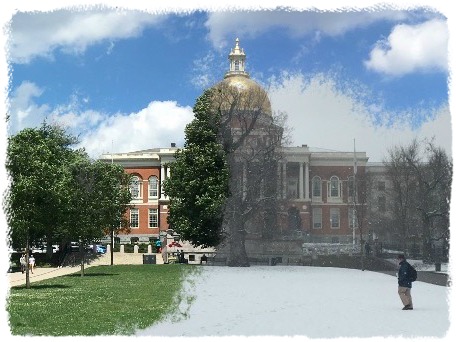
View of the trees from Park Street Station in the Winter and the Summer.
The trees are located on Beacon Street directly across the Massachusetts State House.
PermalinkFan Pier Park

Boston Fan Pier Park
One of the most popular photo spots in Boston is the buildings along the waterfront with the harbor in front. People take this photo from Boston Fan Pier in the Seaport District. It's a nice place to get a harbor side view of the city skyline.
The Boston Harbor Association describes Fan Pier:
From the HarborWalk on the Fan Pier, visitors can enjoy one of the best panoramas of the city, with unobstructed views of downtown to East Boston and the Harbor Islands.
Things I Learned about the Boston Fan Pier Park Area
- Fan Pier first earn its name in 1903 - That's when the New York, New Haven rail lines "fan out" at the end of the line. (There were multiple tracks at the end of the line that was spread out like a fan.)
- By the 1930s the tracks were removed as fishing became more important use of the land.
- More land in the South Boston was filled in the 1950s.
- The United States Courthouse was built here in 1998. It was built so that the rotunda would look like a lighthouse.
- The original estimated construction cost was $184 million (1991). By 1993, the Court House construction project was estimated to be $223 million. It actually cost $170 million upon completion. (Unsure how that happened)
- There is silhouette cut out of ships that use to be in the harbor. These make great photo opportunities. (Try to take a picture so that it looks like the ships are still in the harbor.)
- As you continue to walk down the Fan Pier Park you'll encounter a sign on the sidewalk to inform you where the Edge of Pier 1 was in 1878. (18 78 Historic Edge of Pier 1)
Things I learned about the HarborWalk
Harborwalk, the area in front of Fan Pier Park, was inaugurated on July 4, 1982.
- The goal of Harborwalk was to illustrate all the things that you can do along the Harbor.
- The Harborwalk is highlighted with a dotted blue line. (It's modeled after the Freedom Trail.)
- Harborwalk starts at the Old State House where you can get a guide for free.
- You can also pick up the self-guide walking guide at the Bostix, Boston Common Information booth.
- The Harborwalk is a fifty miles of waterfront - from Boston to Milton.
Directions to Fan Pier
The easiest way to get to the Fan Pier is to take the Silver Line to the Courthouse stop.
Once you get up to the street level, head towards Boston (walk with the direction of the car traffic). You will see a lot of tall buildings in the distance.
At the first light take a left towards a brick building (That's John Joseph Moakley United States Courthouse)
At the end of the road, take a left towards a couple of old bridges, this is the Old Northern Ave Bridge.
Then take a right and walk along the Boston Harbor. This is the Harborwalk.
As you continue to walk, you'll see a sign that welcomes you to the Fan Pier Park.
PermalinkAbout
There are many interesting things and places around Boston, MA that you should know about. Here are a few that caught my attention. From historical sites such as the USS Constitution Museum, the Freedom Trail, and the iconic Fenway Park, to modern attractions like the New England Aquarium, the Boston Public Market, and the Isabella Stewart Gardner Museum, there is something for everyone. Whether you are looking for a fun family trip or a romantic getaway, Boston has it all.
Check out all the blog posts.
Blog Schedule
| Sunday 6 | Misc |
| Monday 7 | Media |
| Tuesday 8 | QA |
| Wednesday 9 | Pytest |
| Thursday 10 | PlayWright |
| Friday 11 | Macintosh |
| Saturday 12 | Internet Tools |
Other Posts
- Boston Bricks
- Fake Monks
- Boston Brownstone
- Jean Louis Lefebvre De Cheverus
- First Independence Day Toast
- Fenway Park
- Captain Jeremiah O'Brien
- Samuel Adams Gravestone
- A. Philip Randolph Statue
- Encore Boston Harbor
- Mario Susi & Sons Marker
- Governor John Brooks
- Joseph A. Langone Jr. Memorial
- Grant Gately Square
- Boston Marathon Monuments